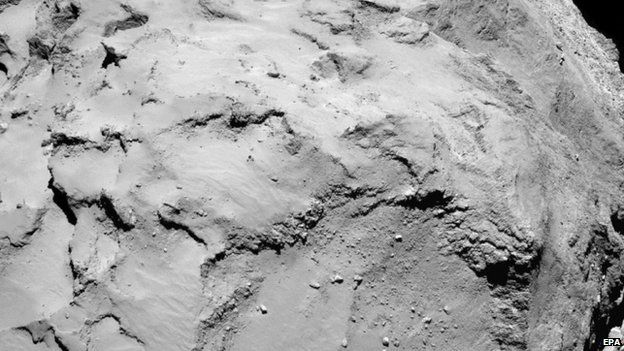Philae comet lander sends more data before losing power
- Published

The exact location of the lander on the comet has not been established yet
The Philae lander on the distant comet 67P has sent another stream of data back to Earth before losing power.
The little probe delivered everything expected from it, just as its failing battery dropped it into standby mode.
Philae is pressed up against a cliff. Deep shadows mean it cannot now get enough light on to its solar panels to recharge its systems.
The European Space Agency (Esa) fears this contact may have been the robot's last - certainly for a while.
A tweet, external from the official Philae lander account said: "I'll tell you more about my new home, comet 67P soon… zzzzz."
Philae descended to the comet's surface on Wednesday - the first time in history that a space mission has made a soft landing on a comet.
The next opportunity to talk to Philae was set to begin at around 10:00 GMT (11:00 CET), when the orbiting Rosetta satellite - which delivered it to the 4km-wide "ice mountain" - was due to come over the horizon.
But with only 1.5 hours of sunshine falling on the robot during the comet's 12-hour day, it seems doubtful the battery will have recovered enough performance to complete the radio link.
Engineers did manage to maximise the possibility of it happening, though, by sending a command to reorientate the lander.
This involved raising Philae by 4cm and rotating its main housing by 35 degrees. This will ensure the largest solar panel catches the most light.
Astrophysicist Elizabeth Pearson: "Philae is not dead it's just sleeping"
Even if the probe falls silent over the weekend, researchers say they are thrilled with the amount of data already acquired.
Stephan Ulamec, lander manager, said: "Prior to falling silent, the lander was able to transmit all science data gathered during the First Science Sequence.
"This machine performed magnificently under tough conditions, and we can be fully proud of the incredible scientific success Philae has delivered."
'Really exciting'
Prof Mark McCaughrean, Esa's senior scientific advisor, told the BBC that the agency was "hugely happy".
"All of the science instruments on board have done all the work they were supposed to do, so we have huge amounts of data back on the ground now, which is really exciting," he said.
"Philae could come back later as we move closer to the Sun, and we get more light on to the solar panels up against the cliff we're at here in the shadows."
In the latest tranche of data are the results from the drilling attempt made earlier in the day.
This had been an eagerly anticipated activity. Getting into the surface layers and bringing up a sample to analyse onboard was seen as central to the core mission of Philae.
Controllers say Cosac, the Philae laboratory that was due to receive the sample, downlinked its data, but that its contents had yet to be assessed.
Communications with Philae were lost just before the expected end of the radio link to Rosetta
Among other returns, Philae took another picture of the surface with its downward-looking Rolis camera.
It also exercised its Consert instrument. This is an experiment that sees Philae and Rosetta send radiowaves through the comet to try to discern its internal structure.
And it has the additional possibility of being used to help triangulate a precise position for Philae on the comet's surface.
This is still unknown. Although the robot hit the centre of its intended landing zone on Wednesday, it then bounced twice before coming to a stop.
Remote observations
Knowledge of that final resting location would enable engineers better to understand its predicament and the prospects for future contact if lighting conditions somehow change on 67P.
This could happen as the comet moves through space on its journey around the Sun. It will have the equivalent of seasons, and this could play to Philae's advantage by altering the angle, timing and intensity of the sunlight hitting the solar panels.
Philae was launched from Earth, piggybacked to the Rosetta satellite, in 2004.
The pair covered 6.4 billion km to reach Comet 67P out near the orbit of Jupiter.
Scientists hope the investigations at the rubber-duck-shaped ball of ice and dust can provide fresh insights on the origins of the Solar System.
Whatever happens to Philae, Rosetta will continue to make its remote observations of 67P
- Published15 November 2014
- Published15 November 2014
- Published14 November 2014
- Published14 November 2014
- Published14 November 2014
- Published13 November 2014
- Published13 November 2014
- Published13 November 2014
- Published13 November 2014